Data for 2022
1. Summary
Engineers Canada’s annual National Membership Report collects information from the provincial and territorial engineering regulators about their membership in order to paint a picture of the engineering profession in Canada. The 2023 report captures data from January 1, 2022, to December 31, 2022. Engineering members are categorized based on the definition of practice in each jurisdiction. Please find all data tables associated with this report here.
Overall, there was an increase in membership in 2022. This increase may be caused by the recovery from the COVID-19 pandemic, but further research is required to comprehensively understand the cause. Data presented in this report and future reports will allow us to better understand how global events impact the career trajectories of engineers in Canada.
Acknowledgements
Engineers Canada would like to thank and recognize the contributions of several staff who helped make this report possible including; Alexandra Baczynska, Yasemin Tanaçan-Blacklock, Vivian Qian, Shelley Ford, Jeanette Southwood, P.Eng., and Gerard McDonald, P.Eng. We would also like to thank Lili El-Tawil, for the French translation of this report, and Matthew Kulka for his work on the presentation of this report.
2. Growth in the engineering profession
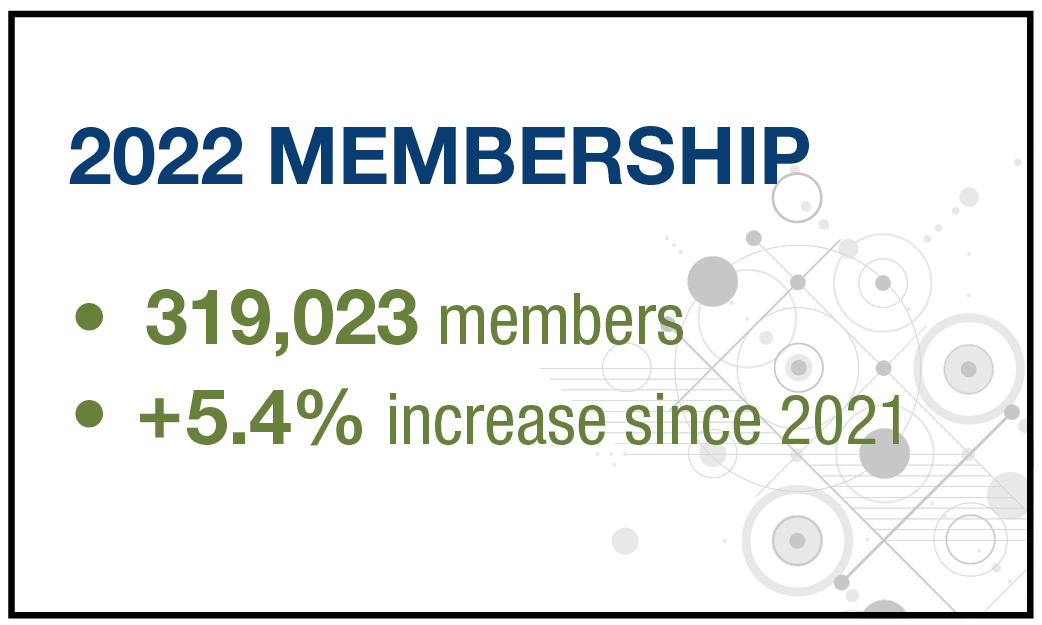
Membership in the provincial and territorial regulators increased from 2021 to 2022. The total national membership as of December 31, 2022, was 319,023 members[1] across the 12 engineering regulators (see Table 1).
This represents an increase of 16,474 members or 5.4 per cent from 2021, whereas the total national membership from 2020 to 2021 only increased by 0.65 per cent.[2] In 2022, the largest increase in members was seen in Quebec with 10,129 more members, and the largest decrease in members was seen in Alberta with 715 fewer members.
3. Newly licensed engineers
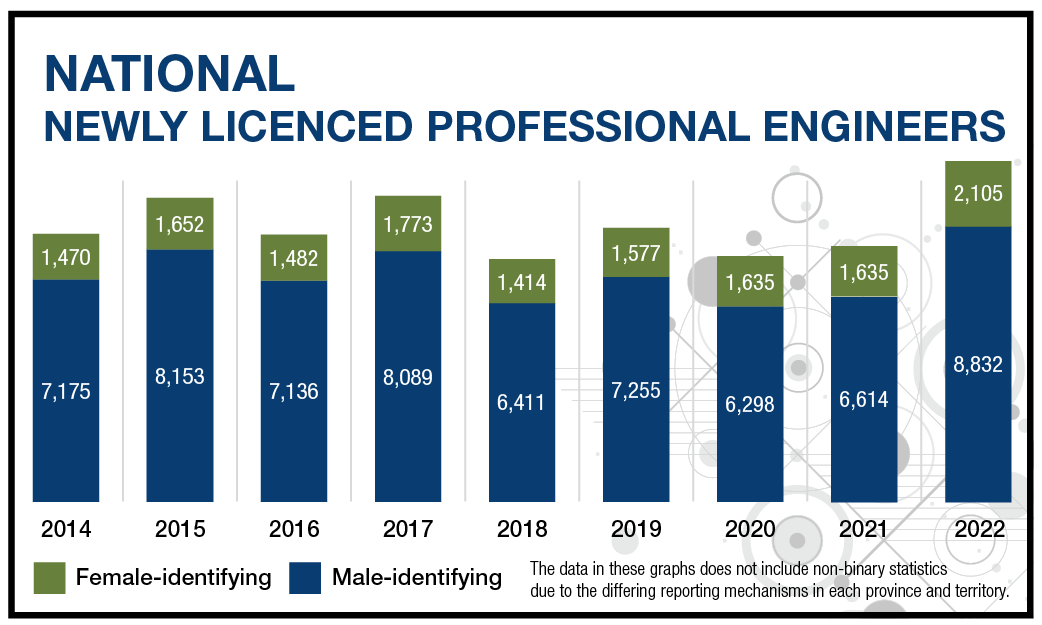
The number of newly licensed engineers[3] across Canada is tracked every year in order to understand the future of the engineering profession in the country. In 2022, there were 10,979 newly licensed engineers, with the largest number (3,314 engineers) obtaining their licence through Professional Engineers Ontario (PEO) (see Table 2). Table 3 provides a nine-year trend of Canada’s newly licensed engineers from 2014 to 2022. Newly licensed engineers increased overall by 33 per cent from 8,255 members in 2021 to 10,979 members in 2022.
4. Engineers-in-training
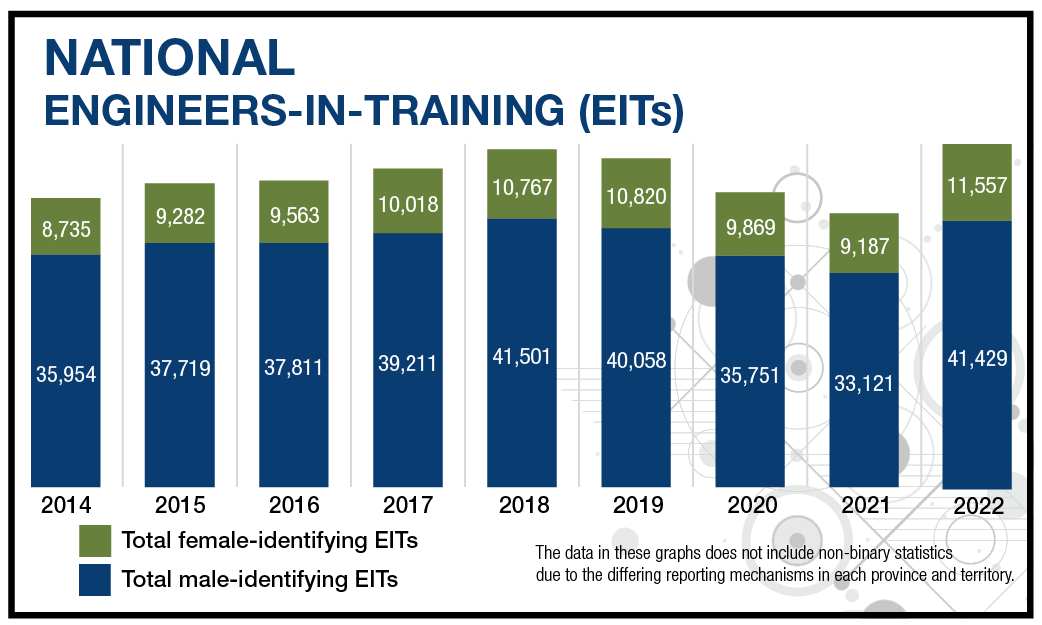
The number of engineers-in-training (EITs) for all sex and gender identities increased between 2021 and 2022 by 10,714 members. Moreover, the proportion of female-identifying EITs increased slightly to 21.7 per cent from 21.6. See Table 4 for the national EIT data from 2014 to 2022.
5. Sex representation in engineering
There are 47,941 female-identifying engineering members, representing 15 per cent of total national membership in 2022[4], up from 14.4% in 2021. There was an increase of 4,276 members who are female-identifying between 2021 and 2022. Quebec achieved the largest increase in female-identifying engineering members with approximately 26.8% per cent growth from 2021 to 2022.
Engineers Canada and the regulators have been tracking the number of newly licensed female-identifying engineers since 2014, as part of the 30 by 30 initiative. In 2015, Engineers Canada launched the 30 by 30 initiative with support from the provincial and territorial regulators. 30 by 30 is a commitment to increasing the proportion of newly licensed engineers who are women to 30 per cent by 2030.
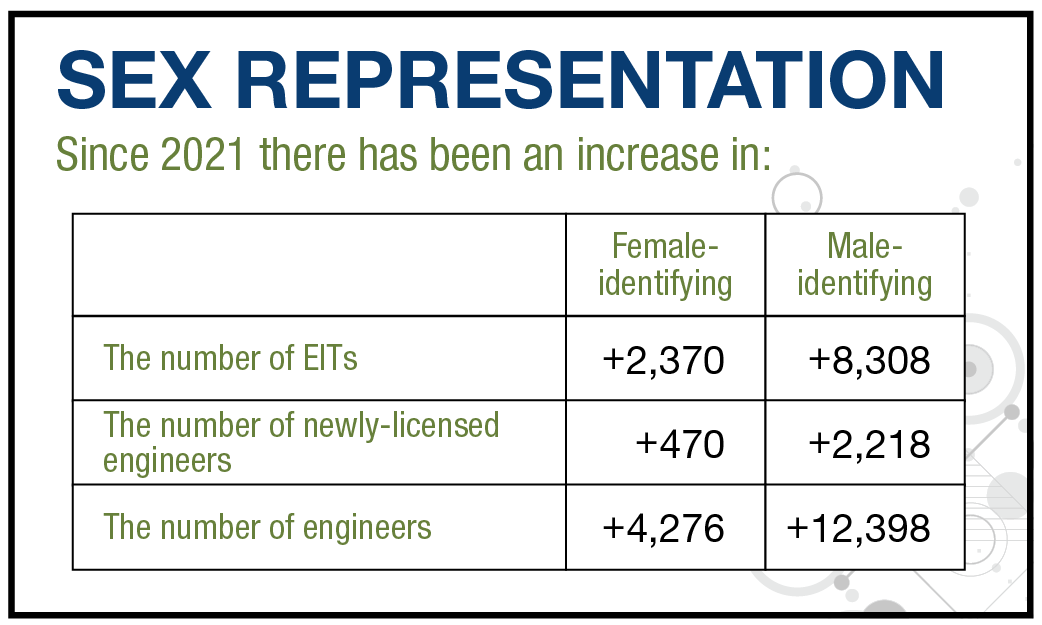
This is one of the metrics for tracking the impact of programs that support gender equity in engineering, since it marks a career milestone for women in their early careers, post-graduation from an accredited program, or for internationally trained engineers entering the Canadian job market.
Female-identifying engineers accounted for 19.2 per cent of newly licensed engineers in Canada in 2022 (see Table 2). The total number of female-identifying individuals obtaining their licence in 2022 was 2,105 members, which is an increase of 470 members from the previous year. Despite an increase in the number of female-identifying newly licensed engineers in 2022, their percentage decreased from 2021 from 19.8 per cent. The number of newly licensed male-identifying engineers increased in 2022 by 2,218 members. This increase in newly licensed male-identifying engineers was significantly higher than that of the newly licensed female-identifying engineers, resulting in a higher proportion of male-identifying engineers.
The largest increases, by region, of newly licensed female-identifying engineers between 2021 and 2022 occurred in British Columbia (224 to 450 members) and Ontario (533 to 680 members). (see Table 3).
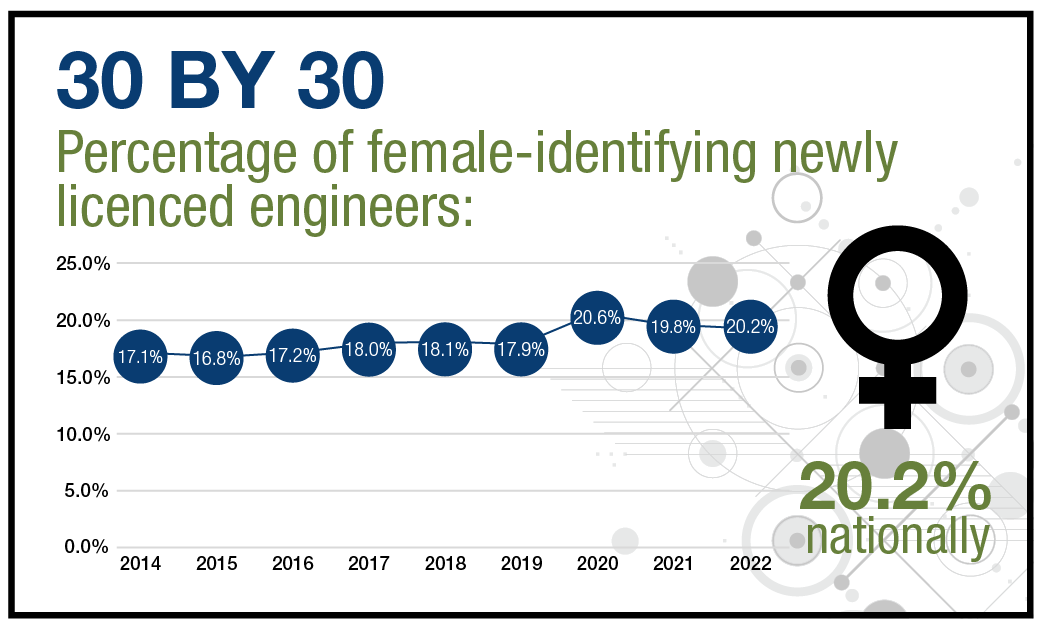
Moreover, the number of female-identifying EITs increased in 2022 to 11,557, the overall proportion of female-identifying EITs was 21.7 per cent in 2022.In 2021, there were 9,187 female-identifying EITs making up 21.6% of the total. See Table 4 for the full breakdown of male and female-identifying EITs.
Engineering student membership saw a small decrease in the percentage of female-identifying members. The representation of engineering student members who identify as female went from 539 students who made up 24.9 per cent of the total to 888, or 24.3 per cent between 2021 and 2022.[i]
Footnotes
i Not all regulators submit data regarding students, for more information on which regions are included in this figure refer to the “Students” data table.
6. From engineering student to professional engineer
Gathering data on the number of engineering students helps us understand how the engineering profession might grow in the future.
According to Engineers Canada’s Enrolment and Degrees Awarded Report 2014-2018,[5] there were 16,497 undergraduate degrees awarded from Canadian Engineering Accreditation Board (CEAB) accredited post-secondary engineering programs in 2018. Assuming it takes a minimum of four years for a graduate from an accredited engineering program to obtain their professional licence, we can estimate that the 2018 graduates (Cohort A) would be obtaining their engineering licence in 2022 and would be captured in the number of newly licensed engineers in this year’s membership data. Using these figures, we can calculate an estimation of the national conversion from graduation to engineering licensure.
In 2022, CEAB graduates accounted for 7,311 (Table 2), or 66.6 per cent, of the total newly licensed engineers in Canada, which is a decrease from 72.7 per cent in 2021. Based on the number of newly licensed CEAB graduates in 2022, it is estimated that 44.3 per cent of Cohort A (16,497 graduates) proceeded along the path to licensure.
In 2017, there were 15,782 CEAB graduates (Cohort B).[6] CEAB graduates accounted for 5,999 or 72.7 per cent of the 8,255 newly licensed engineers in 2021.[7] Using the same analysis as above, we can estimate that 38 per cent of Cohort B obtained their licence in 2021.
Therefore, there is an increase in the proportion of CEAB graduates obtaining their licence after four years between Cohort A (2022) and Cohort B (2021). Although this is an estimation, it is an attempt at measuring the successful continuation of engineering students along the pathway to licensure, the increase could be indicative of the recovery of the career progression speed post pandemic. As described in section 3; “Newly licensed engineers”, the number of newly licensed engineers increased between 2021 and 2022, from 8,255 to 10,979.
The analysis of graduation to licensure is particularly important in understanding the trend for 30 by 30 and how it relates to the increasing trend of female undergraduate enrolment and graduation. CEAB graduates make up the largest pool of potential engineers, including the largest number of newly licensed engineers who are female-identifying. Breaking down the numbers of Cohort A we see that 3,486 engineering graduates were female-identifying in 2018. In 2022, 1,472 CEAB graduates who are female-identifying were newly licensed by the regulators (see Table 2). Using the four-year graduate-to-licensure estimation, it is found that 42.2 per cent of the female-identifying Cohort A CEAB graduates obtained their license in 2022.Meaning female-identifying Cohort A CEAB graduates, have a slightly lower licensure obtainment rate than the Cohort A overall (44.3 per cent). The graduate-to-licensure conversion for male-identifying Cohort A CEAB graduates was 44.7 per cent. In Cohort A, female-identifying engineering graduates are continuing on the pathway to licensure at a slightly lower rate than male-identifying colleagues upon graduation.
To find out more about the 30 by 30 initiative and the 30 by 30 Champions in your province, visit the 30 by 30 webpage.
Endnotes
[1] The category, Members, includes Practising P.Eng.’s (exclusive), Temporary Licence Holders, Licence to Practice Holders, Restricted Licence Holders, Non-Practising P.Eng.’s, Life Members and Engineers-in-Training. It does not include students.
[2] Engineers Canada, 2021. “2021 National Membership Information.” Engineers Canada, Ottawa, Canada. (Link: https://engineerscanada.ca/reports/2021-national-membership-information)
[3] The category, Newly Licensed, includes individuals licensed as Professional Engineers for the first time that are Canadian Engineering Accreditation Board trained, Internationally trained, or have obtained their licence by some other route. It does not include interprovincial mobility applicants.
[4] Sex and gender definition: Sex identifiers have historically been limited to ‘male’ and ‘female’ in the survey of national membership. We use “female-identifying” to describe participants who selected female, and “male-identifying” to describe participants who selected male, be as literal as possible, to limit the assumptions between sex and gender identifiers, and to acknowledge the gender diversity that exists within these sex identities.
[5] Engineers Canada, 2020. “Trends in Engineering Enrolment and Degrees Awarded 2018-2020” Engineers Canada, Ottawa, Canada. (Link: https://engineerscanada.ca/reports/canadian-engineers-for-tomorrow-2020)
[6] Engineers Canada, 2017. “Trends in Engineering Enrolment and Degrees Awarded 2013-2017” Engineers Canada, Ottawa, Canada. (Link: https://engineerscanada.ca/reports/canadian-engineers-for-tomorrow-2017)
[7] Engineers Canada, 2022. “2022 National Membership Information” Engineers Canada, Ottawa, Canada. (Link: https://engineerscanada.ca/2022-national-membership-information#-from-engineering-student-to-professional-engineer)
